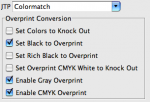[email protected]
Member
We are having the same issues as a poster on the Adobe section. However, his solutions don't work for us.
We are a graphic design studio that receives Illustrator files from many other studios. Many times these studios use spot colors in their drop-shadows and transparencies. When we make whatever revisions we have to make and send the file out to the printer, they can't rip the file properly-- it all comes out as four-color. So then the file comes back to me and I have to spend a lot of time converting each design (it's always more than one--sometimes up to ten) into photoshop DCS files with their respective drop-shadows, etc. and bringing the image back into Illustrator. Needless to say this is a big pain in the a**. What should be a 15 minute job turns into hours.
The printer is using a Creo Prinergy workflow. I've spent hours on the phone with them trying to make these files work as-is to no avail. PDF files won't rip properly either. If I print to pdf separations, the seps come out perfectly. It doesn't work on their end, though.
There's not much I can do since I am not physically there, but I would like to pass on to the printer any advice anyone might have.
Thank You
We are a graphic design studio that receives Illustrator files from many other studios. Many times these studios use spot colors in their drop-shadows and transparencies. When we make whatever revisions we have to make and send the file out to the printer, they can't rip the file properly-- it all comes out as four-color. So then the file comes back to me and I have to spend a lot of time converting each design (it's always more than one--sometimes up to ten) into photoshop DCS files with their respective drop-shadows, etc. and bringing the image back into Illustrator. Needless to say this is a big pain in the a**. What should be a 15 minute job turns into hours.
The printer is using a Creo Prinergy workflow. I've spent hours on the phone with them trying to make these files work as-is to no avail. PDF files won't rip properly either. If I print to pdf separations, the seps come out perfectly. It doesn't work on their end, though.
There's not much I can do since I am not physically there, but I would like to pass on to the printer any advice anyone might have.
Thank You












